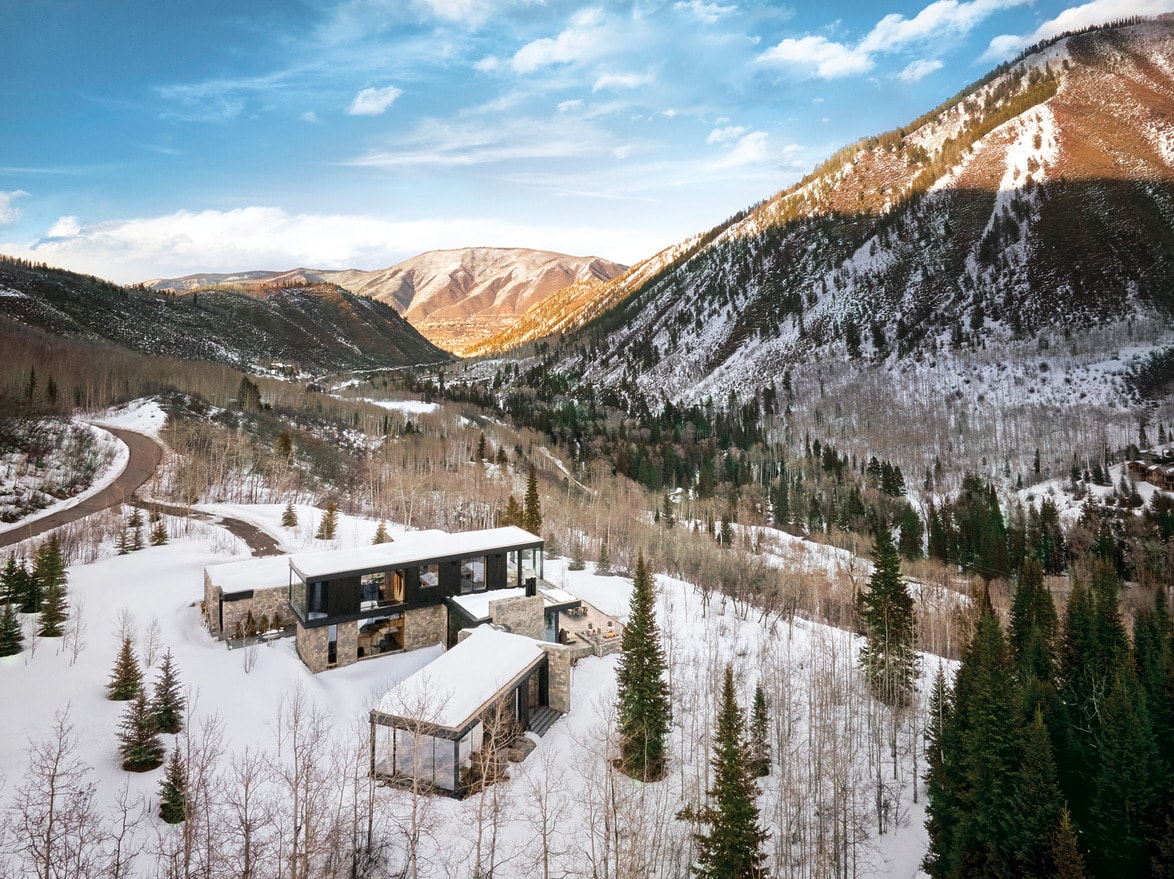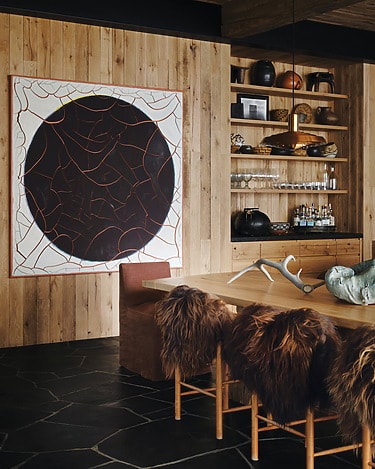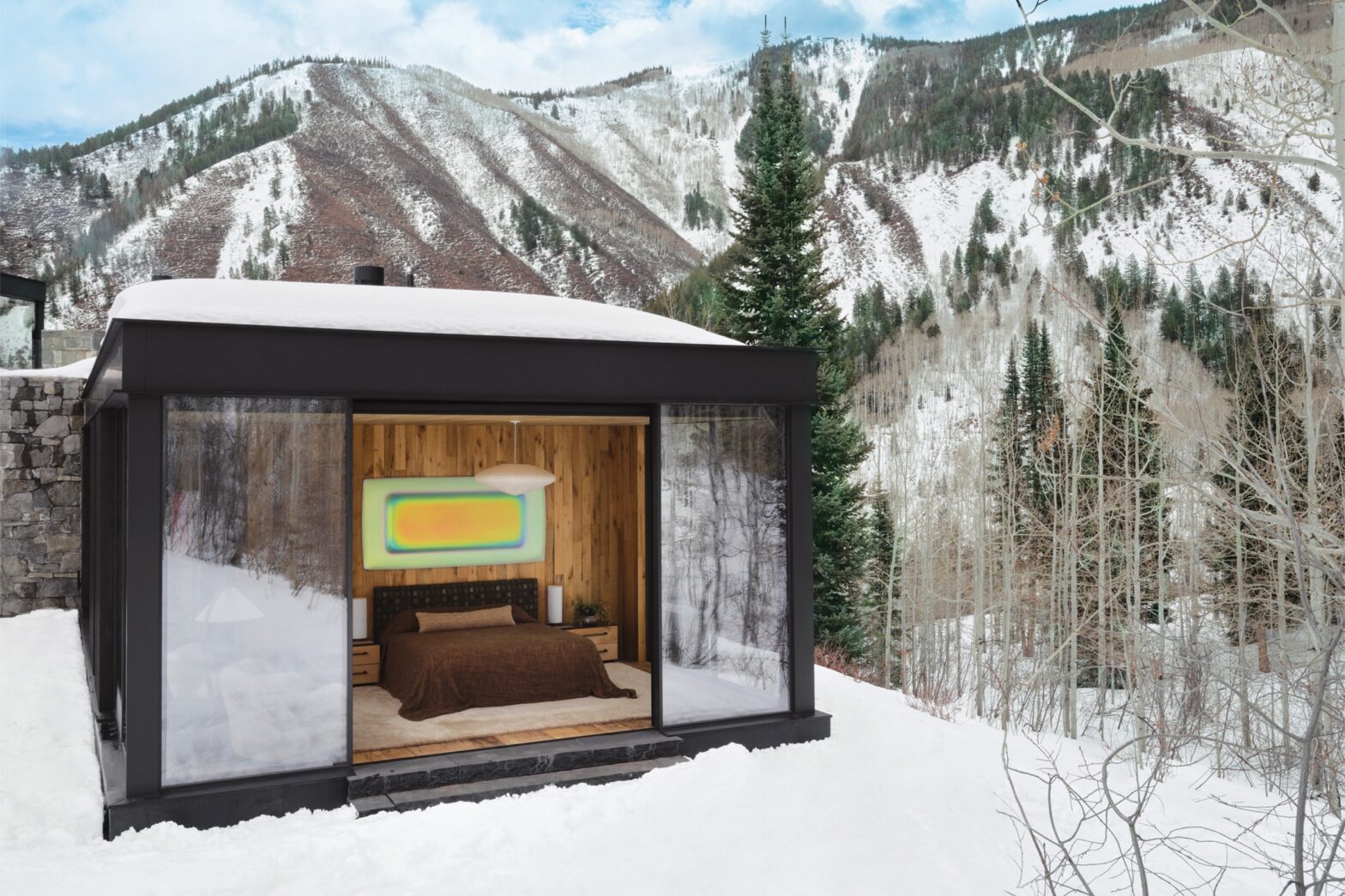Growing up in Austin, Texas, Elizabeth Stanley didn't just play with dollhouses – she saw firsthand how real houses were made. Her father, the founder of a respected home building company, often took her on construction site visits and instilled in her a passion for architecture and design that was as inevitable as the sawdust that tickled her nose. She founded her own business in Austin in 2008, and in the years since, Elizabeth Stanley Design has earned a reputation for enhancing homes with warm, pared-back interiors where new and old elements interact excitingly and natural materials are always at the forefront.
Both she and her husband, private investor Aaron Stanley, are at home in nature and are enthusiastic skiers. A few years ago, they began considering Aspen, Colorado, as an ideal home-away-from-home solution for their family. When they got wind of an 11-acre site on a south-facing slope in the Elk Mountains that included approved plans from Aspen architect Cristof Eigelberger, “we put it under contract sight unseen,” Stanley says. “It’s almost impossible to get building permits in Aspen these days.”


Crafted from steel and reclaimed oak, the staircase is wrapped around Nendo pendants. A painting by Mary Weatherford hangs on the wall, while a figurative sculpture by Stephen De Staebler and a ceramic by Yuji Ueda rest on the black limestone slab floor.


The residence consists of a collection of linear structures, some of which are made of charred wood.
The plans for a 5,750-square-foot collection of interconnected rectilinear volumes were more elegant and modern than what Stanley had in mind, but she says, “I knew I could work with Cristof on the existing design to make it even more our own.” For his part, Eigelberger understood their desire for “a more characterful home,” he says, pointing to their shared commitment to the idea that “everything should be about reconnecting with the land.”


Elizabeth and Aaron Stanley with their three children.
Three years later, the Stanleys and their three children were so excited by the results and the many year-round benefits Aspen offers that they decided to move there full-time. With its layered narrative and organic relationship with its surroundings, the four-bedroom home lives up to Stanley's design brief: “I wanted to make this place as rustic and Rocky Mountain rustic as possible,” she says.
This starts with the exterior, where most of the walls are made of rowan granite, reinforcing the feeling of continuity with the surroundings. The view, as captivating in summer as it is dramatic in winter, benefits from the expansive steel-framed windows Eigelberger installed throughout. The architect grew up in Aspen — “when it still had the Hunter S. Thompson, a skier and a climber vibe,” as he puts it — and so knows “where the sunrise and sunset take place and what that means for the play of light.”


A reclaimed oak ceiling provides a warm contrast to the steel, glass, and stone that surround the living room of the Aspen, Colorado, home that architect Cristof Eigelberger designed for her family in collaboration with designer Elizabeth Stanley. Moose antlers are mounted above the granite fireplace, reminiscent of classic Western style. Living Divani leather sofas and a pair of 1950s modernist Dutch armchairs covered in sheepskin surround a recycled oak cocktail table by Elizabeth Stanley Design. Seating includes an iron stool by Jérôme Abel Seguin, a handsome antique French table and a charred wood table by Michael Wilson. The floor lamp is by Liaigre and the carpet by Vanghent.
A more ghostly presence is the blackened Shou Sugi Ban wood that Stanley chose for parts of the exterior. A few miles up the Castle Creek Valley is Ashcroft, a silver mining ghost town. “So much of the old and weathered wood in Ashcroft is reminiscent of Shou Sugi Ban,” she says, “and I took up that story.”
Inside, Stanley and Eigelberger sourced oak fence boards for many walls and ceilings and salvaged 12-inch-wide threshing boards for some floors. Old oak wood also features in the steps of the sculptural central staircase made of blackened steel.


The kitchen features custom oak cabinetry with flamed basalt countertops, Gaggenau appliances and Toni Copenhagen sink faucets. The counter stools are from BDDW.
More granite was incorporated into the living room's monumental fireplace, whose rough-hewn mantel was finger-toned. Elsewhere, Stanley covered the walls with a textured, soft gray plaster reminiscent of the hue of aspen bark. Further connecting the indoor and outdoor spaces occurs underfoot as broken black stone slabs extend from the entrance across much of the living space to the terrace beyond.
True to her upscale ranchland aesthetic, Stanley designed the kitchen's signature interlocking oak cabinets with open shelves that display earthy, hand-thrown ceramic dishes alongside her collection of vintage wooden bowls. “It was wonderful to see how Elizabeth brought a rustic feel to the house overall,” says Eigelberger.


An artwork by Adriana Varejão overlooks the custom oak dining table, which is surrounded by vintage Charlotte Perriand chairs draped in sheepskin. The linen-covered side table is from Verellen and the counterpart is a vintage chair by Poul Henningsen.


Abstract works by Catherine Lee play with the vibrant patterns of the vintage Navajo blankets that cover the media room floor.
Balancing the friendliness of cattle country with a modernist flair, Stanley filled the rooms with exquisite 20th-century furnishings and refined the fusion with works by contemporary artists such as Mary Weatherford, Ed Ruscha and Adriana Varejão. In a home built on dynamic dualities – sturdy and sophisticated, shaded and bright, hard and soft – sheepskin's plush appeal adds warmth to floors and seating from one room to the next. Opposite the fireplace, modernist 1950s Dutch armchairs are reupholstered in fleece, while small Icelandic furs are draped over the vintage Charlotte Perriand chairs in the dining room, and larger armchairs are ready to lower the temperature when the family eats outside.
Stanley loves cooking and entertaining in all seasons, and the family utilizes the patio's Argentinian-style grill and Rocky Mountain-style fire pit year-round. For a festive après-ski party on New Year's Day, she says, “I piled snow on our outdoor dining table and filled it with champagne, oysters and caviar.” She estimates there were around 75 guests. And it has room for much more.
A version of this article first appeared in print in our Winter 2025 issue under the headline “Elevated State.” Subscribe to the magazine.
